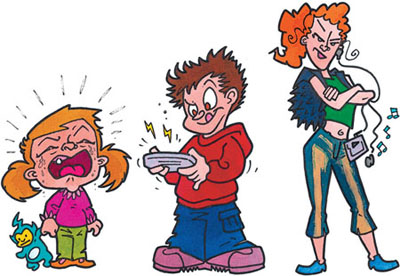Chapter 1
Introducing the Children
Aim
In this chapter the stages of child development and individual personality will be reviewed, and the potential impact of these upon providing dental care explored.
Outcome
Reading this chapter should enable the whole dental team to take a child-centred approach towards the delivery of paediatric dental care (Fig 1-1).

Fig 1-1 Introducing the children.
Introduction
Although each child is an individual, there are well-recognised stages of child development that may give an appropriate framework to approach child management. These are outlined in Table 1-1. Indeed, an understanding of normal child development is essential for anyone who wants to work successfully with children. Once you understand the child’s level of emotional development and maturity you can more easily predict, and correctly interpret, some of their behaviour as it manifests in the surgery. Similarly, it becomes easier to set reasonable, achievable goals for each child. Understanding what to expect of a child in relation to what that child is able to do in life will make the dental team feel less stressed the next time they encounter a “pre-coop-erative” two-year-old, belligerent adolescent or precocious primary school child (Fig 1-2).
| 2-year-old | GDP |
| Self-centred, solitary, easily frustrated, easily distracted and completely dependent on adults. Attention span of 1–5 minutes. Concentrates on one thing at a time. Lives in the present. Favourite word: No! |
Avoid asking questions which can have a “no” answer such as “Would you like me to…?” Keep appointment times short. Invite a parent but not other siblings into the surgery. Concentrate only on the child and avoid interruptions from parents or other staff. Avoid sudden movements. |
| 3-year-old | |
| Exuberant, independent, imitative of adult behaviour, curious, imaginative. Attention span of 4–8 minutes. Eager to please. Favourite word: Why? |
Gain attention by arousing curiosity, describe procedures to the child and ask them to add their own description. Let them “help”. Be positive (e.g. “It’s better if you… ” rather than “don’t do that”). |
| 4-year-old | |
| Dominant, bossy, impatient, insistent. Grasps simple reasoning, is willing to accept change. Enjoys variety. |
Engage the child’s “help”. Explain simple procedures (e.g. “The filling doesn’t stick if the tooth gets wet”). Keep working steadily, avoid pauses, don’t loose control. |
| 5-year-old | |
| Poised, self-confident, aware of rules, likes to act grown-up, less combative, accepts authority. Proud of their possessions. Has feelings that are easily hurt. |
Show interest in possessions /clothes. Appeal to their vanity (e.g. “A dirty tooth… I’ll clean it and put a pretty silver filling in it”; “I need you to help me fix it”. Give praise. Should be able to use a hand signal properly |
Based on Lowrey, Growth and Development of Children, 6th edn. (1974).

Fig 1-2 A pre-schooler.
Milestones in Child Development
Pre-school children (two to four years)
The term “the terrible twos” exists because this age group can be awkward to deal with (ask the parent of any two-year-old). The term “pre-cooperative” describes them perfectly. They have limited communication skills, are very dependent on their parents and do not play or share with others well. When they do speak it is usually to say “No!” as this is their favourite word. Because they cannot express themselves verbally their common response to any upset is to cry. Their parents know that they cry when interrupted while playing, tired or hungry. However, the parents may themselves be stressed during a dental visit and it is important that they are helped to realise that tears for this group are often a normal part of the circumstances, not a sign that something is going wrong. To be successful with this group, the dentist must be quick (an attention span of less than five minutes is normal) and make use of the parents on whom the child remains dependent (see further, Chapter 2).
Three-year-olds
The three-year-old likes to please you but is still very a/>
Stay updated, free dental videos. Join our Telegram channel

VIDEdental - Online dental courses


